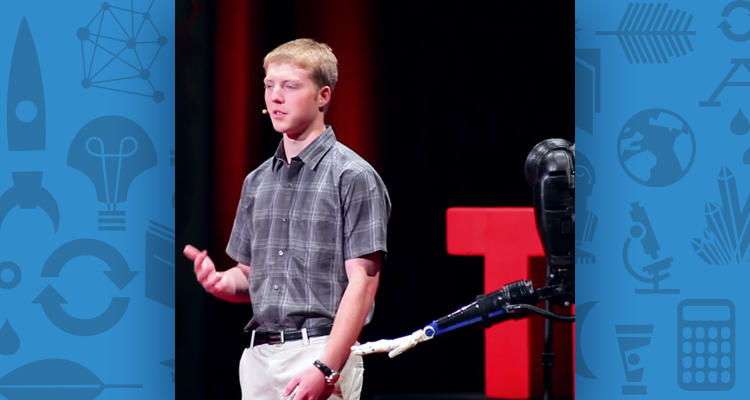The fresh perspective and energy of young hearts and minds has often led to inventions and efforts that have literally changed the world. This is one in a series of articles profiling people who have done just that before their 18th birthday. Our hope is that they will remind you that because of continual progress in education and technology, today’s teens have amazing power and potential to make our lives better in so many ways.
When Easton LaChappelle was 14 years old, he was bored.
But then his boredom gave way to an idea. He decided to make a robotic hand that would mimic movements made with a wireless control glove. The problem was he knew very little about electronics. Not knowing where to start, he searched the Internet and found sites like Instructables that made learning fun and easy, and he set to work using materials he had at home: electrical tubing, electrical tape, toy airplane motors, fishing line, and LEGOs.
Easton successfully built a working robotic hand but decided he wanted something more refined and functional. For his next project, he used stronger motors and more sensitive sensors but kept costs down by using commonly available parts. He also explored modeling software, and engaged the help of a friend who had a 3D printer. When it was done, his robotic arm included a hand with five articulated fingers that could bend and grasp like a human hand.
He brought his creation to the Colorado State Science Fair where it took third place. But more important than placing in the competition, he had a life-changing experience. He met a 7-year-old girl with a prosthetic animatronic arm. Her mechanized hand had only two movements: open and closed—and it cost $80,000. He knew then he wanted to revolutionize the prosthetic industry by producing affordable animatronic limbs.
Building on what he’d already learned, Easton developed another robotic arm that could be controlled through brainwaves sent by a wireless headset that uses Bluetooth technology. Because advances in 3D printing have made production costs so low, this arm, with its neural control system, was made for about $400.
His work caught the eye of engineers at NASA, and at age 17, Easton began interning on their Robonaut project, where he helped to develop robots with fine motor dexterity to assist astronauts in space. Easton also had the opportunity to show his robotic arm to President Obama.
Now 19 years old, Easton has created his own company, Unlimited Tomorrow, where, he said in an Uproxx documentary, he and his friends were “trying to change the world.” He continued to make good on this goal at the 2015 International Consumer Electronics Show where he announced the designs and software for his 3D robotic arm would be available as open source technology, which will allow anyone to use and build on his ideas for free.
“I want to help people,” he said to a TEDxMileHigh audience. “This is something that started from boredom that can change people’s lives. I believe this is the future and this is just the start of it. And what’s gotten me here is curiosity. Curiosity is in every part of us … I challenge you to challenge the system and look beyond all the boundaries. And to be curious.”
Learning from Easton LaChappelle
In five years, Easton went from bored to brilliant. Looking at his life, we can learn a few things about how to change the world:
- Be curious. As Easton said, curiosity gave him his start. What are you interested in? What would you like to know more about? Allow yourself to wonder and ask questions—then see where it takes you.
- Don’t worry about what you don’t know. When he started, Easton didn’t have a clue about how to make a robotic hand. Do as he did, and start looking for educational resources on the Internet. You could also join a club at school or take a K12 STEM-related elective. A lot of what you need may be right at your fingertips.
- It’s okay to start small. There’s a basic beginning to every project, and progress is made a step at a time. Easton built his first robotic hand with LEGOs and fishing line. What’s your basic beginning?
- Be on the lookout for an “Ah-ha!” Easton called his encounter with the seven-year-old girl who had a prosthetic arm his “Ah-ha” moment. He saw how his science fair project could meet a huge need around the world. What’s your idea? How could it work in a bigger picture, on a wider scale?
People have asked if Easton LaChappelle is the new Steve Jobs. Looking at how he got started, maybe you could be the next Easton LaChappelle.
[embedvideo id=”CfmNXPMjChs” website=”youtube”]
Featured Image – TEDxMileHigh




































